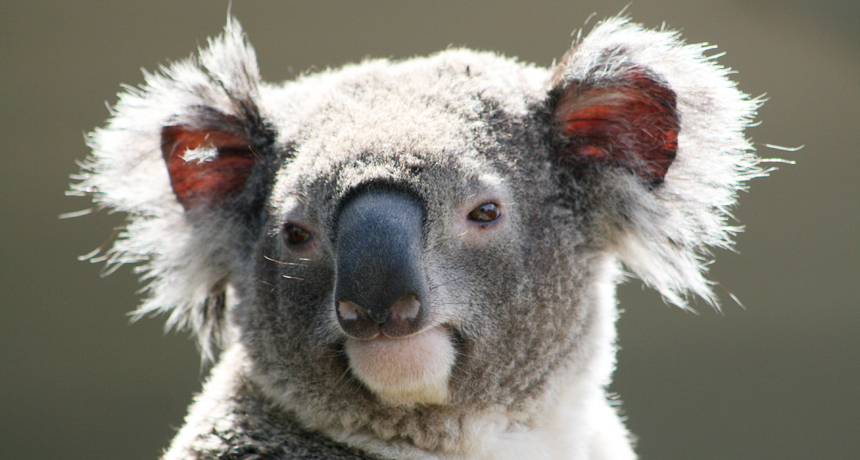Koalas’ very deep voice
An unexpected extra set of vocal cords lets males hit some surprisingly low notes

How can a relatively tiny koala belt out mating songs in a bass range more typical of elephants? The answer is outside their voice box.
Poco a poco/Wikimedia Commons
By Beth Mole
Scientists have just turned up a second set of vocal cords in koalas. These bonus vocal cords allows males to hit tones 20 times lower than would be expected from an animal its size.
The size of an animal’s voice box and its flapping vocal cords dictate the range of pitches that an animal can make. For a typical 8-kilogram (17.5-pound) male koala, its voice should fall within the near-soprano range of any animal choir. Yet the male’s mating songs include very low bellows — tones usually created only by elephant-sized mammals. Although these tones may make a female koala swoon, to the human ear, the low-pitched sounds resemble only a string of belches and snorts.
A team of scientists wanted to probe how the serenading guys reach those deep bass tones. To find out, Benjamin Charlton led a team that dissected the voice boxes of 10 male koalas. A biologist who has worked in zoos, Charlton now works at the University of Sussex in Brighton, England.
His research group found that koalas possess a unique, second set of vocal flaps. The bonus ones reside outside of the voice box. Their placement allows them to belt out those low, low tones. These extra vocal cords make the koala quite unusual, both in terms of its anatomy and its acoustics —those sounds it makes, observe the scientists in the Dec. 2 issue of Current Biology.
Power Words
acoustics The science related to sounds and hearing.
larynx (also called avoice box) The uppermost part of the tube-like structure — the trachea — that runs from the throat into the lungs. In most vertebrates, this upper region contains flaps of tissue known as vocal cords. As air passes through them, they create sound — the animal’s voice.
trachea A tube-like structure that carries air from the throat into the lungs of vertebrate animals. Rings of cartilage reinforce this structure in mammals, creating what’s known as a windpipe.
marsupials Mammals that carry their young for a period after birth in external pouches where the developing babies will have access to their mother’s nipples — and milk. Most of these species evolved in Australian and have especially long hind-legs. Examples of marsupials include kargaroos, opossums and koalas.
vocal cords A pair of membranes that are stretched over the opening of the larynx. They open when someone inhales air. They close when someone holds his or her breath. But most importantly, they provide sounds — the voices — of animals when air is expelled from the lungs and squeezed through them. Animals can control the tension in these membranes, and how much they open. This provides the pitch of a sound and how loud it is, from a whisper to a bellow.







